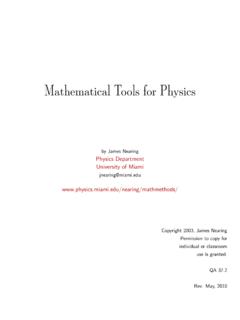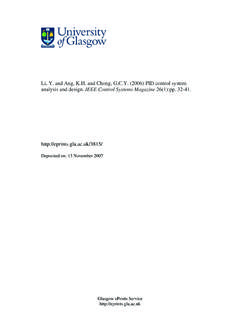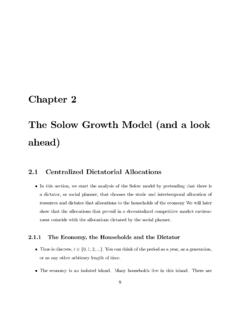Transcription of Vector Calculus 2 - University of Miami
1 Vector Calculus 2 There s more to the subject of Vector Calculus than the material in chapter nine. There are a coupleof types of line integrals and there are some basic theorems that relate the integrals to the derivatives,sort of like the fundamental theorem of Calculus that relates the integral to the anti-derivative in IntegralsRecall the definition of the Riemann integral from section badxf(x) = lim xk 0N k=1f( k) xk( )This refers to a function of a single variable, integrated along that one basic idea is that you divide a complicated thing into little pieces to get an approximateanswer.
2 Then you refine the pieces into still smaller ones to improve the answer and finally take thelimit as the approximation becomes is the length of a curve in the plane? Divide the curve into a lot of small pieces, then if thepieces are small enough you can use the Pythagorean Theorem to estimate the length of each piece. `k= ( xk)2+ ( yk)2 xk ykThe whole curve then has a length that you estimate to be the sum of all these intervals. Finally takethe limit to get the exact answer. k `k= ( xk)2+ ( yk)2 d`= dx2+dy2( )How do you actuallydothis? That will depend on the way that you use to describe the curve with the simplest method and assume that you have a parametric representation of the curve:x=f(t)andy=g(t)Thendx= f(t)dtanddy= g(t)dt, sod`= ( f(t)dt)2+( g(t)dt)2= f(t)2+ g(t)2dt( )and the integral for the length is d`= badt f(t)2+ g(t)2whereaandbare the limits on the parametert.
3 Think of this as d`= vdt, wherevis the Nearing, University of Miami113 Vector Calculus 22Do the simplest example first. What is the circumference of a circle? Use the parametrizationx=Rcos , y=Rsin thend`= ( Rsin )2+ (Rcos )2d =Rd ( )The circumference is then d`= 2 0Rd = 2 R. An ellipse is a bit more of a challenge; the curve is expressed in polar coordinates you may find another formulation preferable, thoughin essence it is the same. The Pythagorean Theorem is still applicable, but you have to see what it saysin these coordinates. `k= ( rk)2+ (rk k)2rk k rkIf this picture doesn t seem to show much of a right triangle, remember there s a limit involved, as rkand kapproach zero this becomes more of a triangle.
4 The integral for the length of a curve is then d`= dr2+r2d 2To actually do this integral you will pick a parameter to represent the curve, and that parameter mayeven be itself. For an example, examine one loop of a logarithmic spiral:r=r0ek .d`= dr2+r2d 2= (dr/d )2+r2d The length of the arc from = 0to = 2 is (r0kek )2+(r0ek )2d = 2 0d r0ek k2+ 1 =r0 k2+ 11k[e2k 1]Ifk 0you can easily check that this give the correct answer. In the other extreme, for largek, youcan also check that it is a plausible result, but it s a little harder to IntegralsThe time for a particle to travel along a short segment of a path isdt=d`/vwherevis the total time along a path is of course the integral dt= d`v( )How much time does it take a particle to slide down a curve under the influence of gravity?
5 If the speedis determined by gravity without friction, you can use conservation of energy to compute the speed. I lluse the coordinateymeasured downward from the top point of the curve, thenxymv2/2 mgy=E,sov= (2E/m) + 2gy( )13 Vector Calculus 23 Suppose that this particle starts at rest fromy= 0, thenE= 0andv= 2gy. Does the total timeto reach a specific point depend on which path you take to get there? Very much so. This will lead toa classic problem called the brachistochrone. See section for the straight-line path from(0,0)to(x0,y0). The path isx= `= dx2+dy2=dy 1 +x20/y20,soT= d`v= y00dy 1 +x20/y20 2gy= 1 +x20/y201 2g12 y0=12 x20+y20 2gy0( )xy2 There are an infinite number of possible paths, and another choice of pathcan give a smaller or a larger time.
6 Take another path for which it s easy tocompute the total time. Drop straight down in order to pick up speed, thenturn a sharp corner and coast horizontally. Compute the time along this pathand it is the sum of two pieces. y00dy 2gy+ x00dx 2gy0=1 2g[12 y0+x0 y0]=1 2gy0[x0+y0/2]( )Which one takes a shorter time? See if the path is a parabola,x= It drops rapidly at first, picking up speed, but thentakes a more direct route to the end. Useyas the coordinate, thendx= ,andd`= (4y2x20/y40)+ 1dyT= dxv= y00 (4y2x20/y40)+ 1 2gydyThis is not an integral that you re likely to have encountered yet.
7 I ll refer you to a large table ofintegrals, where you can perhaps find it under the heading of elliptic more advanced treatments of optics, the time it takes light to travel along a path is of centralimportance because it is related to the phase of the light wave along that path. In that context however,you usually see it written with an extra factor of the speed of cd`v= nd`( )This last form, written in terms of the index of refraction, is called the optical path. Compare and Line IntegralsWork done on a point mass in one dimension is an integral. If the mass moves in three dimensions andif the force happens to be a constant, then work is simply a dot product:W= xfxiFx(x)dxrespectivelyW=~F.
8 ~rThe general case for work on a particle moving along a trajectory in space is a line integral. It combinesthese two equations into a single expression for the work along an arbitrary path for an arbitrary is not then any restriction to the elementary case of constant Vector Calculus 24 The basic idea is a combination of Eqs. ( ) and ( ). Divide the specified curve into anumber of pieces, at the points{~rk}. Between pointsk 1andkyou had the estimate of the arclength as ( xk)2+ ( yk)2, but here you need the whole Vector from~rk 1to~rkin order to evaluatethe work done as the mass moves from one point to the next.
9 Let ~rk=~rk ~rk 1, thenlim| ~rk| 0N k=1~F(~rk). ~rk= ~F(~r).d~r~r0~r1~r2~r3~r4~r5~r6( )This is the definition of a line do you evaluate these integrals? To repeat what happened with Eq. ( ), that will dependon the way that you use to describe the curve itself. Start with the simplest method and assume thatyou have a parametric representation of the curve:~r(t), thend~r= ~rdtand the integral is ~F(~r).d~r= ~F(~r(t)). ~rdtThis is now an ordinary integral with respect tot. In many specific examples, you may find an easierway to represent the curve, but this is something that you can always fall back order to see exactly where this is used, start with~F=m~a, Take the dot product withd~randmanipulate the expression.
10 ~F=md~vdt,so~ ~r=md~ ~r=md~ ~rdtdt=md~ ~rdt=m~ ~vor~ ~r=m2d(~v.~v)( )The integral of this from an initial point of the motion to a final point is ~rf~ri~ ~r= m2d(~v.~v)=m2[v2f v2i]( )This is a standard form of the work-energy theorem in mechanics. In most cases you have to specifythe whole path, not just the endpoints, so this way of writing the theorem is somewhat misleading. Isit legitimate to manipulate~ ~vas in Eq. ( )? Yes. Simply write it in rectangular components asvxdvx+vydvy+vzdvzand you can integrate each term with no problem; then assemble the result asv2 ~F=Axy x+B(x2+L2) y, what is the work done going from point(0,0)to(L,L)along the threedifferent paths C1~ ~r= [Fx x+Fy y].












